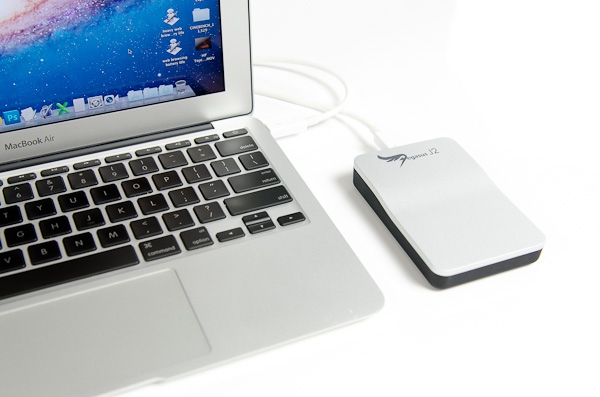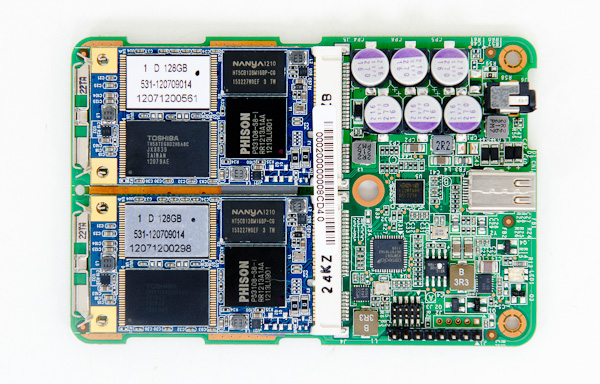Promise Pegasus J2 Review: The Smallest High Performance Thunderbolt Drive
by Anand Lal Shimpi on September 2, 2012 1:00 PM ESTFinal Words
I really like the uniqueness of the Pegasus J2. Two 6Gbps mSATA drives in a well-built bus powered enclosure that gains additional performance when plugged into the wall is a great way to deliver the best of both worlds. Sequential IO performance, particularly on the read side is amazing. You can get the performance of a 6-drive Pegasus R6 in a fraction of the volume. The chassis is well built and the design is functional.
The big issues with the J2 are its capacity constraints and the Phison controllers used by the integrated SSDs. The former is really a limitation of current NAND die sizes. The best 2-bit MLC NAND shipping today still tops out at 8GB per die, with a maximum of 8 die in a package (64GB per package). It's only really possible to fit 4 NAND packages (256GB) on a standard mSATA board, which limits the J2 to a maximum capacity of 512GB. If that's all the space you need for an external work drive (e.g. as a video project drive for a rMBP or MacBook Air), then you'll be fine, but otherwise it can be an issue.
My other complaint has to do with the use of Phison controllers on the mSATA SSDs. I understand the appeal, but there are simply better options on the market. I'd much rather see something like the Micron C400 mSATA drive integrated into the J2.
The concept behind the J2 is neat and honestly makes a lot of sense. The right way to do this would be to integrate custom form factor SSDs into a tiny Thunderbolt enclosure (e.g. Zenbook Prime/MacBook Air form factor). A larger form factor would allow you to hit 512GB per drive (or more), while sticking with an internal RAID-0 would help take advantage of what Thunderbolt has to offer. You only really need two good 6Gbps SSDs to max out Thunderbolt after all.
Kudos to Promise on breaking the mold with the Pegasus J2, but I'd at least like to see better SSD controllers used inside.












24 Comments
View All Comments
nealibob - Sunday, September 2, 2012 - link
I'll take an empty one for $100ammar.m - Sunday, September 2, 2012 - link
it's ridiculous how insane the prices on all these thunderbolt drives are. why can't they make a regular 320GB/500GB external drive using thunderbolt and give us blazing speeds for 150$? because if they can't do that then this technology is next to useless. Show me how many people would prefer to purchase a 8TB drive over a regular 500GB oneA macbook(where thunderbolt is commonly found) is a consumer based laptop, NOT something you'd expect a budding business to purchase for its employees. so why do drives that cost more than the freakin laptop itself continue to popup? who buys these? I would love to see some sales figures on this.
Zak - Sunday, September 2, 2012 - link
The prices indeed need to come down or TB will be a failure. But I hope this won't be another FireWire 800 since Intel is behind this. Once the interface is on every OEM PC and every mobo the tech ought to become affordable.dsumanik - Monday, September 3, 2012 - link
Fail Fail FailFail 1: Two Cables
Intel created thunderbolt to provide a high bandwidth link for display, peripherals, and storage on a single cable. Why create a product which defeats the intended design spec to begin with? Management should have caught this one, its simply a facepalm, find a SSD that can work in the power envelope and design a passive chassis that doesnt require a fan?
Fail 2: Crap controller in a shiny box.
Two junk SSD in raid 0. What could possibly go wrong?
Nuff Said.
Fail 3 : Unseemly, greedy and outrageous price markup.
Yet another company trying to cash in on the Apple design mentality, make it metal, shiny and well constructed...fill it with the same generic parts as everyone else and then up the price tag 250%.\
Where The *uck is my plain jane, sub 50$ empty and BUS powered external aluminum TB chassis.
Please, nobody buy this...teach them a costly lesson.
inplainview - Sunday, September 2, 2012 - link
I can afford it easily but I won't. The price is crazy,jwcalla - Sunday, September 2, 2012 - link
Throw me in the ring as a bit of a doubter myself. If it's going to be pushed as primarily an interface for peripherals, I have to say "meh" for now, considering the cost. Just use eSATA for something like external disks.Give me something like 10 GbE over TB, and my ears perk up. That seems like something of value. I don't think we'll see Intel go there though.
The whole spec seems kinda proprietary and locked down.
Pneumothorax - Monday, September 3, 2012 - link
Agreed, Intel/Apple's decisions are going to either kill this standard or relegate it to a firewire niche. Their decision to restrict to Apple use only for the 1st year along with their stupid nanny policy of 'You have to certify with us first before we'll let you release it' have really slowed adoption down. Latest dumb move is when they didn't allow mobo manufacturers to devise a discrete GPU thunderbolt pass-through interface.Samus - Tuesday, September 4, 2012 - link
what's ridiculous is all the retired baby boomers blowing their social security income and pensions on this overpriced tech to match their overpriced apple craptech6 - Sunday, September 2, 2012 - link
The problem with the J2 is that a normal SSD for less than $1/Gb is plenty fast enough for even the most I/O intensive work. The marginal value of this Thunderbolt/RAID-0 setup is questionable - particularly if is comes in at $3/Gb.MadMan007 - Sunday, September 2, 2012 - link
"Two are beneath two of the rubber feat"Pesky spellcheck!